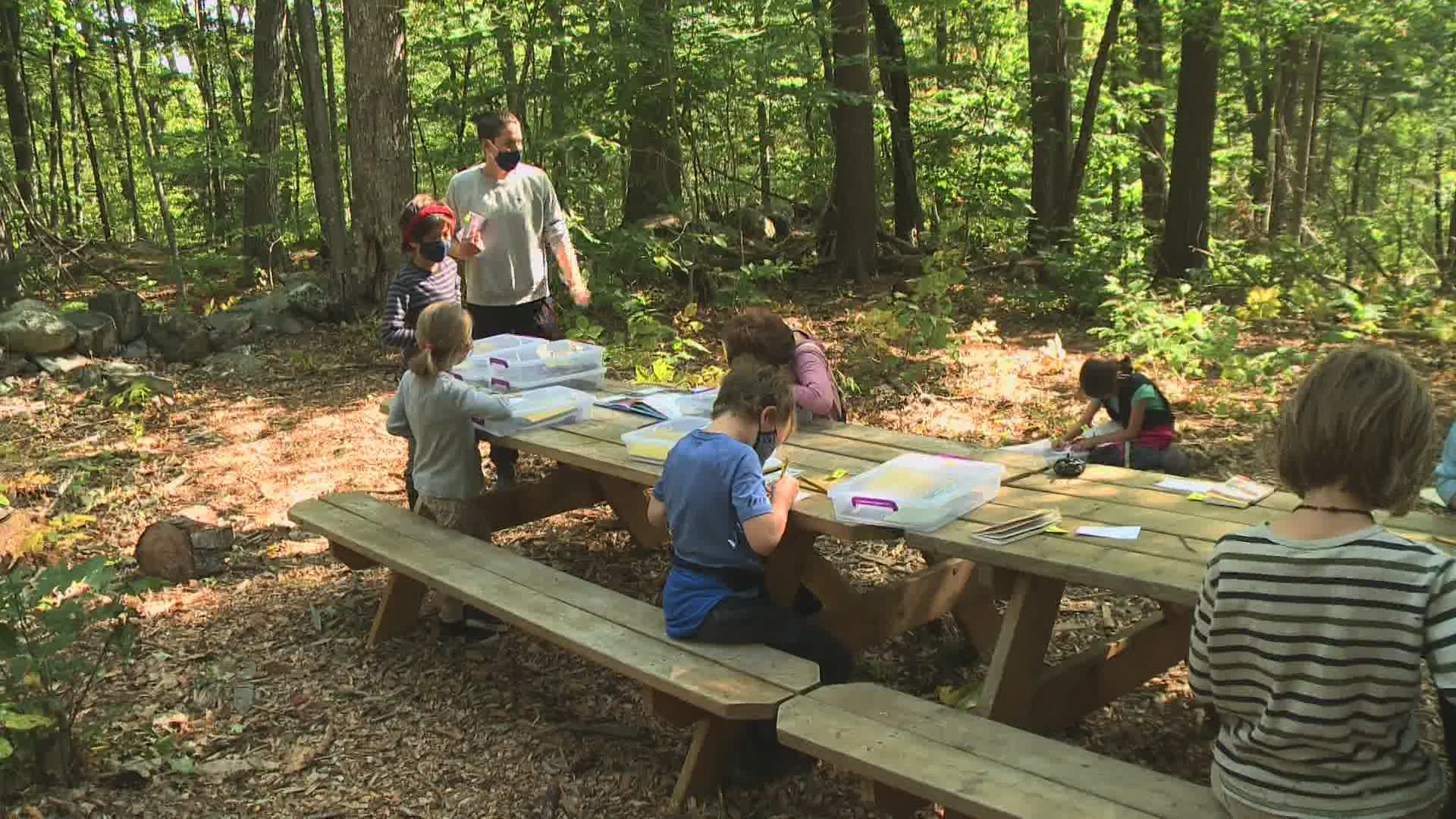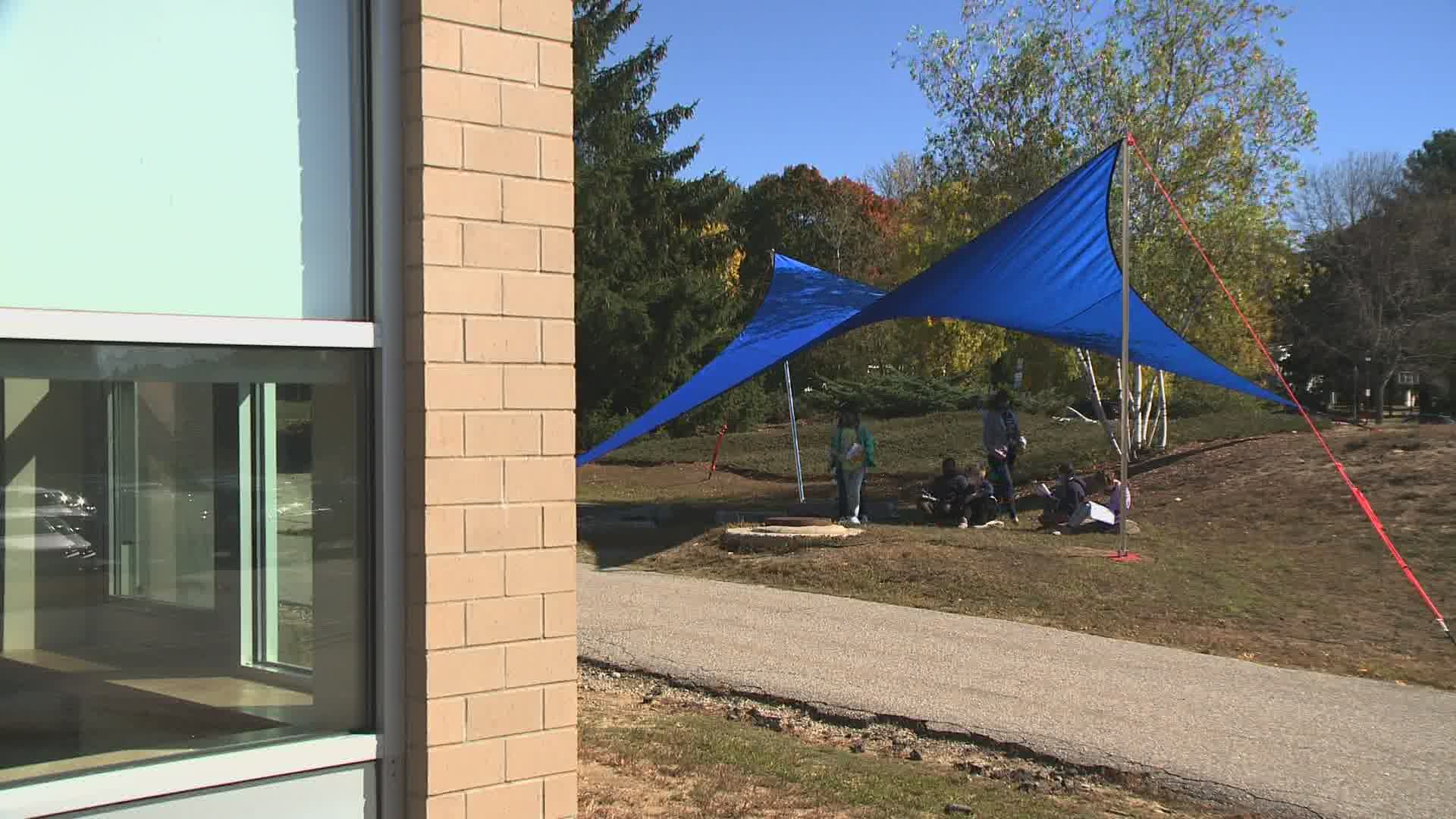ALNA, Maine — UPDATE: To watch Part One of the series, see video within story.
There's a shift in the air of public school systems, as administrators work to keep the air clean and children in class. It's those classrooms that are changing; from plexi-glass indoors, and more work being done with students outdoors. For that outside help, some teachers are looking to the founder of a nature-based school in Alna.
Anne Stires founded Juniper Hill School ten years ago. There's no oversized brick building, no desks, no lockers to shove textbooks into, or even a playground. She wanted her school to consist of nature based learning, which means the classrooms are the woods and the fields on her 40 acres.
"So when I think about traditional, I think about skills and knowledge that's been here for longer than the white settlers of Maine," Stires explains. "I think about much longer than that, and indigenous tradition and community; this is what that actually looks like. So what we now call 'traditional schools' is really quite recent actually."
Students at Juniper Hill are still learning reading, writing, math, and science - the basic educational curriculum - but lesson plans also incorporate the world around them; bugs, birds, building shelters. The more their hands get dirty; the more the students seem to absorb their lessons, which is why Logan Neale wanted her son to attend this school.
*To learn more about Nature-based learning:
"As a mother, as a parent I understand how special this is," says Neale. "I don't think he would do well in a traditional 'sit at a desk inside,' not for hours. I know kids get to play in public schools, but yes, this environment seems to suit him very well."
Students at Juniper Hill are outside on beautiful, warm fall days; but also in the middle of winter, or during rain storms. The trees help shelter their books, and the kids are dressed for the elements - and yes, there are risks that come with that. Stires uses her school to help train others.
"And we joke: how long will it take before the first question, which is usually bathrooms. Second only to what we do in the winter time?" The answer to the first question is typically, what's the easiest solution? For public schools, probably going back inside to use the bathroom. The second question takes a little more work. "We live in a country of plenty, that does not mean everyone has access. You have to find where the access points are and it's not just on the families, and it's not just on the school, it's a community effort to find out how we get the clothing out there in plenty for the students," says Stires, "and the teachers, they need it too."
Two years ago, Stires started hosting an institute for teachers from all over the country, helping them dip their toes into outdoor learning. She says 90% of those who attend are from public schools; and this year Stires has been doing a lot more consulting work with some of those schools looking to get outside.
"Sometimes that's followed up with me going to the school and thinking about where are the possibilities. Where is it already happening?"
Nina Willette is in her first year as principal of Georgetown Central School, just 20 minutes down the road from Juniper Hill. This summer, she sent two of her teachers to learn from the Institute.
"Then we invited parents and teachers to our Outdoor Committee meeting and we sort of organized our community members and put pieces together," Willette explains. What administrators found was that parents and community members were happy to help, piecing together more than 15 outdoor classrooms and donating rain and snow gear for students who need it.
Right now, in this small Maine town, outdoor learning is working well in adjacent to classroom learning. These students are in school five days a week.
"We are learning what it's like for our kids to be outside, and there might be individual kids where it could be distracting so we have to make adjustments and differentiate, but teachers are equipped to do that; they've been trained to do that," says Willette. "So I think curriculum wise for me I've just asked teachers to focus more on project-based learning and bring in nature as much as possible."
"The kids have more of an opportunity to take their masks off because we know it's safe outside," says Georgetown Central School teacher, Marcie Look. "It's really engaging; being outside really engages all of the senses, so the kids just kind of light up. Maybe you came outside to do reading and there's a 10 minute detour because you're looking at the bald eagle that flew over or you're investigating the camouflage that bugs have as they climb up the trees."
"When you're inside and you're using maybe a worksheet to drive instruction it can be a little tricky, not everyone buys into those topics," says Look. "When you're outside and the kids are interested in something, the walls are taken down; usually there's major interest in what we are studying and you can harness that enthusiasm and excitement and go from there."
Which is what stands out about Juniper Hill School and its outdoor classrooms that came years before a pandemic forced teachers to get creative… engaged students.
Anne Stires believes every school, no matter their location, can take lessons from her nature-based school. "That is the reason we exist," says Stires. "I know that we have got to come together around health and around well-being and so I think that this is one way. I'm not saying it's the only way, I know some teachers will say, 'Well I teach with a SMART Board and technology,' and I say, 'You can do it all! And let's figure out how.'"
While outdoor classrooms are working for a smaller school like Georgetown Central; we wanted to know if it could work in Maine's largest city: Portland.
The Portland Public School system is responsible for more than 6,500 students from Pre-K through 12th grade. At Gerald E. Talbot Community School this year, kids are split into two cohorts. They come to class two days a week, then learn remotely the rest of the week. While at school; their classes regularly move outside.
"We have some [outdoor classrooms] that are in the woods that are just magical, the students love them. We have some that are more out in the sun with new sunshades," says principal, Ann Hanna.
Schools like Talbot are using the space around their building to let their students breathe a little easier while focused on classwork.
"The most connection happens when you are face-to-face and you get to work every single day with these kids," says teacher, Allison Richards. "It's so apparent and evident in our connection that we get to share in this outdoor space together." Richards admits, there has been a learning curve with her 2nd graders; who are used to coming outside for recess or physical education. That's why each outdoor classroom has designated seats, borders, or covers.
While nature is incorporated in some lesson plans, the work these students are doing is almost exactly what you'd see inside a 'traditional classroom.'
"Our initial goal was just to get outside and do what we do indoors outdoors," says Brooke Teller, who is the STEM coordinator for Portland Public Schools; and has taken on the interim role as the district's outdoor learning coordinator. "Now folks are starting to ask, 'Well, how can I teach about the fall leaves? What is this science that's going on there?' So now we're starting to look at curriculum around that."
"Our music teacher has been able to bring her kids outside and learn about the natural phenomenon around us, and they're singing songs about trees and the seasons and they're able to move around more," says Hanna. "They wouldn't be able to do that inside."
Setting up outdoor classrooms takes work and money, and there's no 'one size fits all' approach. Classes within the same building may need different things; and each building within a district is different. "High schools are definitely looking to have better access to Wi-Fi outside; and I think in terms of the level of priorities for the district were trying to get devices into students hands first," says Teller. "Then we'll tackle some of those hotspot issues because there are definite times where it would be helpful for teachers and students to be able to hop onto their devices."
"We're at approximately $120,000 [spent on outdoor learning], but that outfits 5000 students with learning kits and we have over 156 outdoor learning sites at our 17 buildings," says Teller. Some of that cost was covered with funding through the federal CARES act; the rest, has come from some popular neighbors.
"Allagash [Brewing] has been really helpful in providing whiteboards and folding chairs. Maine Mead Works has also donated a lot of the buckets that are being used at the elementary level. We have the Carpenters Union 349 helped build 204 easels and that was with the help of the United Way of Greater Portland making that connection for us," Teller explains.
Teller has also been getting some help from Anne Stires and Juniper Hill School.
"There are several of us who are consultants for Inside-Outside and for Antioch University, now educational consultants doing this work in the schools," says Stires. "I teach whole classes on setting up the four walls of your outside classroom so that teachers feel like they can."
Stires believes education should involve the entire community; and so far with each of the public schools she's worked with, there has been a lot of community support to get students outside - right down to making sure each child has the right gear to stay outside, even as the weather cools down.
Right now at Gerald E. Talbot Community School, the goal is to have students outside for 50% of their time at school; that will likely change come winter, but Teller says they're working on it.
"Phase 1 was acquiring the materials to get outside. Phase 2 was these shade structures that we're going to have to at each building from a company called Transformit, they've been super helpful about designing and engineering these for us. Phase 3 is hats and gloves for our students that can't provide them for themselves, so we are talking with L.L. Bean for that and our Foundation for Public Schools has a donation button.
In the meantime, teachers like Allison Richards and her second grade class, are happy for more time together. "Myself as a teacher, it feels hard to put in all the time that I would love to do to create the spaces and get the kids everything they need, so if there are people in the community who are passionate about getting kids outside and keeping them safe outdoors, reach out to your community schools and see how you can help."
PART 1
PART 2


